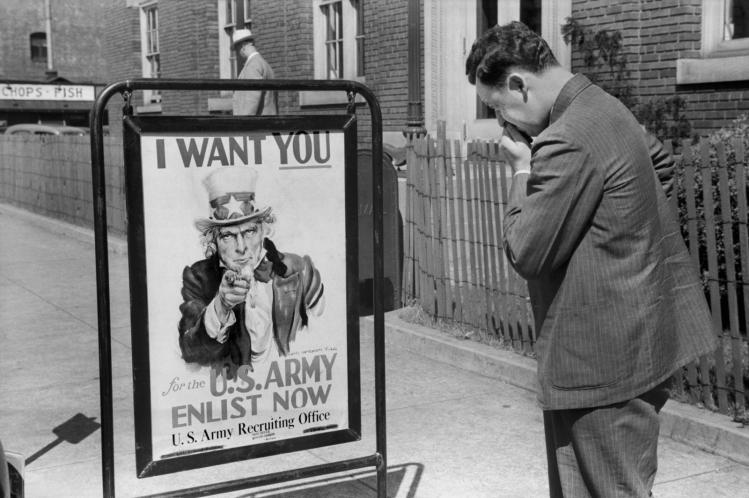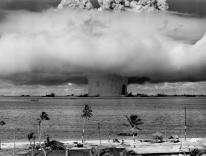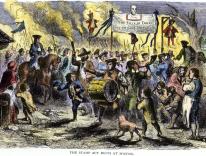
Since 1997, Elizabeth Samet has been teaching literature to cadets at the U.S. Military Academy. To judge by her most recent book, she must be an engaging, inspiring, and utterly subversive classroom presence.
Looking for the Good War suggests that she is fearless as well. Sprawling and discursive—as a writer, Samet adheres to the no-notecard-left-behind school of literary studies—her book takes up the delicate subject of World War II revisionism. Samet aligns herself with the controversial view that the “Good War” may have been less than altogether good.
Reexamining and revising the past is a continuous and necessary exercise. At West Point, it’s a safe bet that Lee Gate, Lee Barracks, Lee Hall, Lee Road, and the Robert E. Lee Mathematics Prize, all honoring a certain Confederate general once deemed a role model for graduating cadets, will soon bear different names.
When it comes to World War II, however, revisionism tends to be an especially touchy subject. Early practitioners charged an ostensibly duplicitous President Franklin D. Roosevelt with conspiring to maneuver the United States into an avoidable war. Some subsequent revisionists trafficked in Holocaust denial. More recently, with the achievements of the “Greatest Generation” celebrated in bestselling books and blockbuster movies, merely to suggest that considerations other than God, mother, and apple pie influenced the war’s conduct seems very unpatriotic, if not altogether indecent.
Samet dismisses as fraudulent the feel-good interpretation of the war to which most present-day Americans subscribe. “The so-called greatness of the Greatest Generation is a fiction,” she writes, “a sentimental fiction, suffused with nostalgia and with the need to return to some finest hour.” Her self-assigned task is to poke holes in the “selective memory”—more precisely, the invented memory—that props up the mythic narrative of the “Good War.” She is hardly the first to do so, of course. Indeed, her account cites writers ranging from war correspondent Ernie Pyle and novelist Joseph Heller to scholars such as Paul Fussell, all of whom have previously exposed aspects of the war’s underbelly, albeit with only limited effect.
Emphasizing popular fiction and film noir (while leavening the text with a healthy dose of Shakespeare), her own contribution to this ongoing enterprise highlights “the dangerous and seemingly indestructible fantasy” that the next American war, wherever and whenever it occurs, will replicate the “good” one of 1941–1945 and produce suitably redemptive results. Yet in reality, she notes, that war served as a “prologue to three-quarters of a century of misbegotten ones,” including those that her former students have fought in Afghanistan and Iraq. These conflicts she characterizes as “interminable and inconvenient,” not to mention “embarrassing”—about as different from the remembered version of World War II as they can be.
Colorful but irrelevant embellishments permeate the text. A page devoted to the fate of the French liner Normandie offers an example. Docked in New York Harbor in 1939, the opulent vessel caught fire and capsized, never to serve as a troopship as U.S. authorities had hoped. “There is a photo of [Marlene] Dietrich,” Samet writes, “in one of four grand suites, the Rouen, in front of its piano.” Further detail follows. Readers learn that the ship’s whistle, which once announced shift changes at Bethlehem Steel, is now on display at the Pratt Institute. Pittsburgh’s Carnegie Museum owns several of the ship’s murals, while “the magnificent doors of the grand dining room now adorn Our Lady of Lebanon Church in Brooklyn.”
Other topics include Ulysses S. Grant’s reading habits during his days as a cadet at West Point; the prewar German American Bund’s embrace of George Washington as the “first Fascist”; the penchant of souvenir-hungry G.I.s for scouring battlefields (and enemy dead) like “Gilded Age robber barons”; and the purging of Cold War–era U.S. government-supported libraries abroad of anything written by “known Communists or fellow-travelers.” None of Samet’s excursions are less than interesting. Some are fascinating. What they have to do with “the myths that constitute this book’s central subject” tends to be elusive.
Where Samet is most insightful is in her survey of early postwar depictions of World War II veterans. On that score, she appears to have read every pulp novel and seen every B-movie released during the first decade after the war. Her central finding is that when wartime memories were fresh, the cultural status of those who had fought was anything but exalted. On the contrary, writers and filmmakers depicted former G.I.s as alienated, angry, violent, and prone to various forms of antisocial behavior—the currently dominant Ronald Reagan/Tom Brokaw/Steven Spielberg interpretation turned upside down.
With the onset of the Cold War, however, casting the World War II veteran in the role of anti-hero became distinctly unhelpful. The rationale and conduct of the anti-communist crusade derived much of its moral justification from the conflict that had ended in 1945 in unambiguous triumph. When President Reagan paid tribute to “the boys of Pointe du Hoc” as “the champions who helped free a continent” during a visit to Normandy in 1984, he was implicitly praising their successors who had fought in Korea and Vietnam and those who even then were manning the ramparts along the Iron Curtain. Wherever they served, “the troops” were engaged in what were by definition campaigns of liberation.
On that score, Samet writes, “There is no more important part of the myth of World War II...than the figure of the American soldier as an agent for good in the world.” Ever since 1945, Americans have kept “searching for a hero as satisfying and uncomplicated as those favorite images of GIs distributing Hershey bars to children or receiving bouquets of flowers from grateful women.” For members of a public with decidedly little interest in the actual conduct of more recent American wars, the belief that the troops fighting in places like Iraq and Afghanistan are themselves agents for good provides a handy excuse for avoiding hard questions.
Samet does not reflect on whether her former students, some of them killed, maimed, or otherwise bearing the scars of war, distributed candy or received flowers in the course of their duties. If any did so, the moment was incidental. But unless I am misreading her, she is outraged that the willful misremembering of World War II sustains the “nostalgia, sentimentality, and jingoism” that find the United States in our own day more or less perpetually at war.
As enshrined in American memory, she writes, “World War II galvanized a faith that America was different, special, unique in the history of nations.” Once upon a time, that characterization may have been plausible and even useful. It no longer is. Acknowledging that the United States is not different, special, or unique might provide a step toward enabling her students to enjoy longer, happier, and healthier lives.
Looking for the Good War
American Amnesia and the Violent Pursuit of Happiness
Elizabeth D. Samet
Farrar, Straus, and Giroux
$28 | 368 pp.
Please email comments to [email protected] and join the conversation on our Facebook page.
Previous Story
Poem | Cave Painting
Next Story
Julia in Teotitlán Del Valle, Oaxaca, 2021


